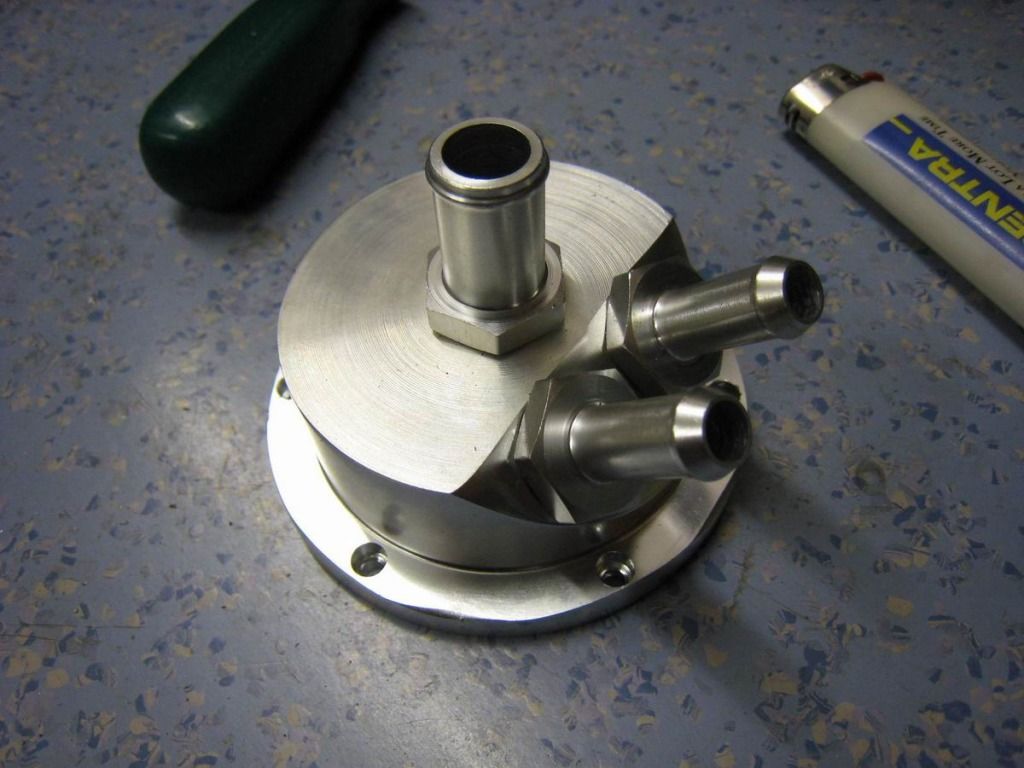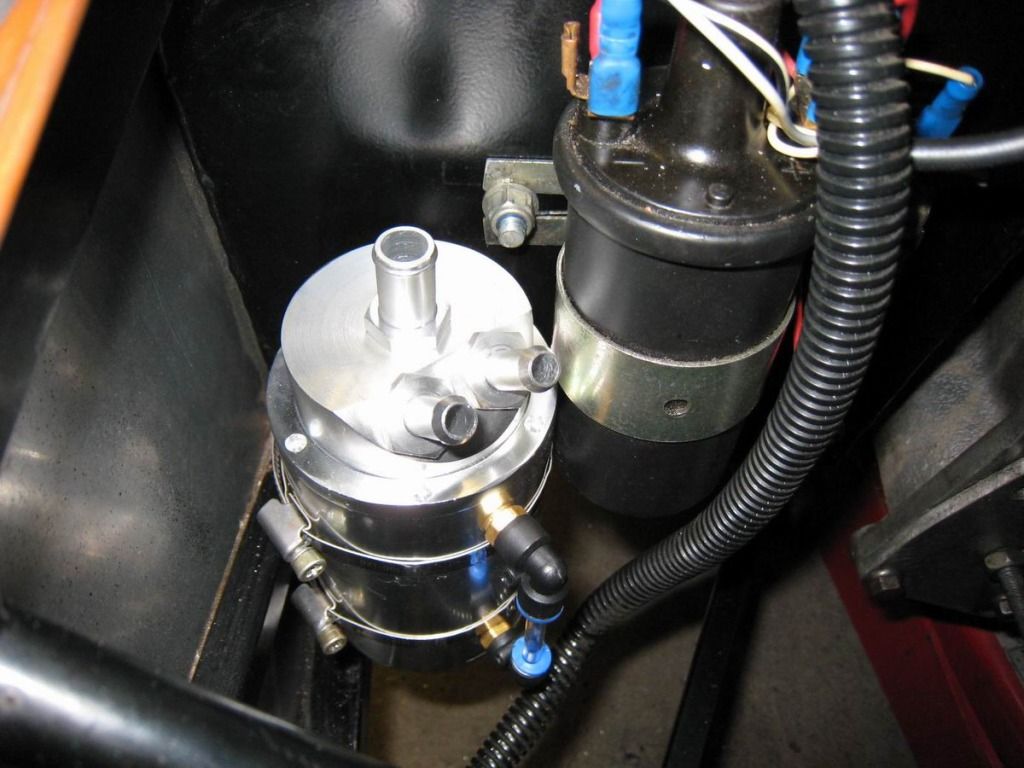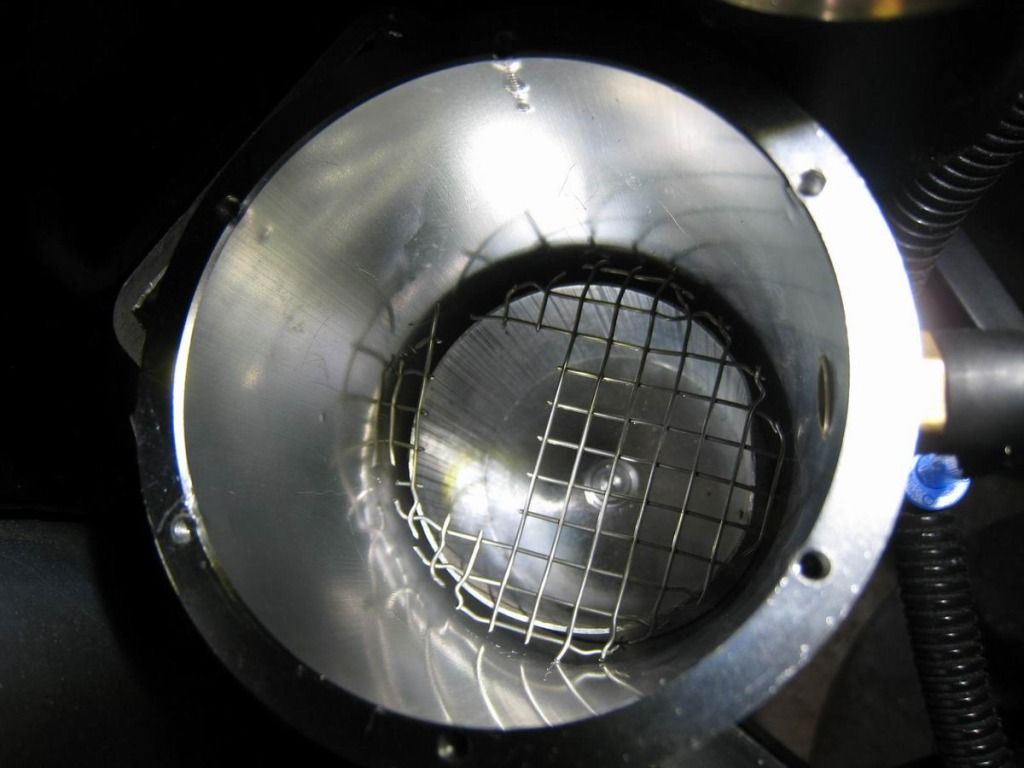
Oil Catch Tank Design for a Crossflow
philfingers - 23/1/13 at 03:02 PM
The breather system was plumbed with the stock block breather and the ally valve cover breathing back into the inlet manifold, which isn't good,
the engine could suck outof the crankcase. So I purchased one of these ally oil catch tanks that are prolific on ebay, inside was what I suspected-
nothing; it was empty! The idea really is to catch the oil out of the oil mist and seperate it, expelling the now oilless air to atmosphere.
So firstly i removed the stock block breather and fitted a 'competition' version which I'd had kicking around for 15 years!

you can see the fuel pump blanking plate below it, this has an addional L plate on the back, which stops oil being thrown up the breather from the
cam. nice and easy to make.
So the oil catch tank [£18 inc del off ebay] come with two angled spigots as standard, so I machined the top off it and fitted a third.


Now inside there's a short [40mm maybe] length of 60mm diameter thin wall ally flue pipe, which supports a st/st mesh. Pipes come from the
inside of the angled spigots into the tank, passing through some st/st scourer pads and through a opening in the mesh towards the bottom of the
tank


The idea is the block and valve cover pipes enter the catch tank and pass through the scourer pads [in their respective pipes] and the mesh [there to
support the scourer off the bottom of the tank] to the bottom of the tank. Here the oil mist will move to a lower pressure which is out of the top of
the tank through the newly fitted third spigot. This will ultimately be vented through a long pipe down the tunnel and out the back of the car. As
the oil mist passes through the scourer it should drop out into the scourer and then fall back into the bottom of the tanks. Well that's the
theorey!
Years ago my old Striker was a heavy breather and the pipes went into a plastic catch tank under the bonnet with a K&N filter/breather thing on
the top, as you drove along on a sunny day the oil mist would arise out of the hole around the gearstick as a sort of oil mist tornado! Left hand
always smelt of oil and the inside of the engine bay got covered in oil mist etc. So Iím trying to avoid that with this system. Itís possibly that
if it was mounted higher up it could auto drain back into the sump. Letís see if it works first
Advice and thoughts appreciated. I suspected I may need a bigger one! The tank is 1 litre, but half of this is scourer!
Alfa145 - 23/1/13 at 03:13 PM
Nice job.
On my Xflow I piped the crank breather to the rocker cover then have a single pipe from rocker cover filler cap to catch tank.
The reason I did this was my crank breather was p!ssing oil out by the gallon and filling the catch tank in 5 laps. pipped to rocker so it recycles
and breathes from the filler cap. Been working fine now for several thousand miles.
steve m - 23/1/13 at 03:56 PM
"On my Xflow I piped the crank breather to the rocker cover then have a single pipe from rocker cover filler cap to catch tank.
done mine the same way
Paul Turner - 23/1/13 at 04:27 PM
Cannot understand why the X-Flow's are breathing so much oil. If the engines are in good condition with good sump baffling they should be fine.
Ran engines from 1660 to 1860 for 14 years (135 bhp to 175 bhp) using 234, 244, 254 and K3A cams and never had a problem. Pipe from standard Ford
breather (with valve removed) to plastic bottle and pipe from rocker cover to the same bottle. Even on a track day I never saw more than 1" of
oil in the bottom.
To breath such large amounts there must be fundamental problems with the piston/bores or sump baffling.
johnemms - 23/1/13 at 06:06 PM
On heavy-fast acceleration - occasionaly it chucked it out.. So..
I piped the crank breather to the rocker cover then have a single pipe from rocker cover to catch tank. (New 1700cc with BCF2 cam)
No problems.. driving it like I stole it,...
[Edited on 23/1/13 by johnemms]
philfingers - 23/1/13 at 06:10 PM
having never driven this car I have no idea how it breathes, but I wanted a decent catch tank to help. I'll see later in the year once it's
on the road how it breathes. I agree, with good ring sealing it shouldn't blow much out, unless it's a mechanical issue such as the cam
flinging oil out the breather
spaximus - 23/1/13 at 06:19 PM
When the X flow engine is normally running the breather is connected to the inlet side of the engine. When the engine runs the inlet vacuum pressure
sucks the pressure out of the crankcase and recycles it.
When you take this off there is no vacuum and the result is that the pressure blows out into the atmosphere.
philfingers - 23/1/13 at 06:25 PM
yes but should be connected the the airbox side, not the inlet manifold, between the carbs and the valves as mine was!
steve m - 23/1/13 at 07:02 PM
I dont run an air box, hence my arrangement
steve
Paul Turner - 24/1/13 at 07:37 AM
quote:
Originally posted by spaximus
When the X flow engine is normally running the breather is connected to the inlet side of the engine. When the engine runs the inlet vacuum pressure
sucks the pressure out of the crankcase and recycles it.
When you take this off there is no vacuum and the result is that the pressure blows out into the atmosphere.
Correct when standard with standard carb but when you fit twin webers, bike carbs or similar you cannot do it like that.
Also remember that arrangement only works with a fit engine. Putting oil mist into the air fuel mixture causes detonation which as we all know is bad.
If the engine is breathing heavily the detonation caused will probably cause serious damage.
As I said above breathing the block and rocker cover into a bottle will work fine but if the engine is not in good condition you will see oil in the
catch tank. Also remember that if you put the breather into a bottle the crank valve must be removed from the standard Ford breather. It needs the
inlet vacuum to work.
Overfilling with oil will also cause the engine to kick out the excess into the catch tank as will a poorly or unbaffled sump under track conditions.
alfas - 5/6/14 at 02:33 PM
even the thread is old , there are 2 mistakes in the pictured arrangement:
1. when running an electrical fuel pump you need to use the blanking plate with deflector:

2. the alloy ellbow, replacing the original tin-can breather, is a waste of money. use the original tin breather, with PCV valve removed, connected to
a catch tank or the rocker-cover and the majoritiy of oil will get catched already on the block-exit.
job done.
JMW - 5/6/14 at 02:44 PM
The OP specifically mentions between the first two pictures that he has an "L" shaped fitting on the inside of the blanking plate.
My 83.5mm bored xflow with Accralite pistons breathes no oil at all. Not a drop. Prior to this, with a +90 bore and 1300gt pistons it did. I am
informed that the rings on the Accralites are superior and I put it down them.
philfingers - 5/6/14 at 03:32 PM
Alfas- read the post first, regarding the L shape bracket
The arrangement works well, the most I've got is about an inch in that little pot, that was after 500 miles. It works really well for ducting
the fumes out the back of the car though
Car it here, yellow one front left!
http://www.completekitcar.co.uk/Issue/latestissue.html
alfas - 5/6/14 at 07:54 PM
oh...sorry ...my mistake...i did not see that the thread opener was already mentioning the L-shaped part.....






